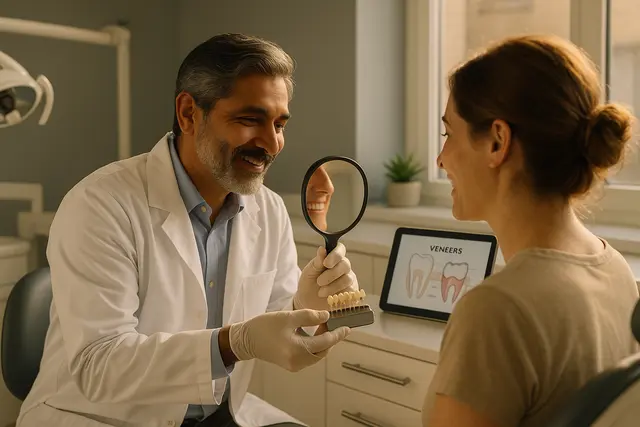Cosmetic Dentistry
6 min read
Mar 19, 2025
Veneers vs. Dental Bonding: Which Fixes Chipped Teeth Faster?
Chipping a tooth never makes your day better. Whether it happened mid-bite into a crusty baguette or during an epic stumble over your own shoelaces (no judgment), the result is the same: you’re stuck staring at the mirror, wondering how fast you can fix this thing. Two big players enter the chat, veneers and dental bonding. But which one gets your smile back in action faster?

Veneers: The Hollywood Smile in Thin Layers
Veneers are usually made of porcelain or composite resin, that are custom-made to cover the front surface of your teeth. You’ve probably heard celebs swear by them. And yes, porcelain veneers look amazing when done right, white with opalescent quality, even, flawless. But fast? That’s another story.
Getting porcelain veneers typically involves two or more dental visits. Your cosmetic dentist starts by prepping the tooth, removing a small amount of tooth enamel, and taking conventional or digital impression to send to a dental laboratory. While you wait for your permanent veneers, you’ll usually be given to wear temporary veneers that protect your underlying tooth structures.
Once the porcelain veneers are ready, they’re bonded to your teeth using dental adhesives. It’s a dental procedure that takes precision, skill, and just a little bit of patience. Veneers are custom-made to match the color of your natural teeth, but they can also be used to brighten and enhance your smile if you’re looking for a full makeover. And while veneers are more expensive, they often last 10–15 years with regular dental visits and proper care.
Bond: The Quick Fix That Packs a Punch
On the other end of the spectrum is tooth bonding. This cosmetic dental procedure is kind of the unsung hero of chipped tooth repair. Dental bonding involves applying a tooth-colored composite resin to the surface of the tooth, shaping it to look natural, and then hardening it with a curing light.
The best part? Bonding is a quick fix. Most cases are handled in a single dental visit, with no need to send anything off to a dental laboratory. So, if you’re racing the clock, maybe you have a wedding, a date, or just want to stop running your tongue over that chipped tooth, bonding may be your best friend.
Composite bonding is especially handy for small chips, minor gaps, or discoloration. While not quite as long-lasting as porcelain, bonding usually holds up for about 3 to 10 years, depending on how well you take care of your teeth and whether you avoid biting into hard objects like frozen chocolate bars or opening bottles with your restored tooth. (Seriously, please don’t.)
Tooth Bonding: What to Expect During the Procedure
Tooth bonding is a fairly faster dental procedure. There’s usually no need for anesthesia unless the chip or decay is near the pulp or involving it. The cosmetic dentist starts by roughening the surface of the tooth just a little, so the bonding material bonds well to the tooth.
Then comes the application of the composite resin material, which is shaped to match the natural curve of your tooth. Once it looks just right, it is cured with a special light. After that, a little finishing and polishing, and boom, you’re done. The whole thing can take as little as 10 to 60 minutes per tooth.
Compared to veneers, bonding is a cosmetic procedure that requires less tooth preparation. Henceforth, makes it a great choice if you want to keep things reversible or just aren’t ready for permanent veneers.
Bonding and Veneers: The Cosmetic Contenders
So, what’s the real difference when it comes to bonding and veneers? It boils down to time, durability, aesthetics and repairability. Also, indirect veneers are contraindicated in individuals with parafunctional habits like bruxism.
Veneers are custom-made, so they take longer, but they offer more stain resistance and a more dramatic change. Bonding is fast and budget-friendly, but it can stain over time and isn’t quite as durable. If you bite on hard objects or chew on pens, your bonded composite might debond sooner than you’d like.
Still, cosmetic bonding has come a long way, and for many people, it’s the perfect balance of convenience and cosmetic upgrade. If your dentist thinks the chip is minor, they may recommend bonding as the most efficient route.
Dental Bonding: A Deep Dive Into the Details
Dental bonding is a cosmetic dental procedure used to repair chipped or cracked teeth, close small gaps, or even make your teeth look longer. It can also be used for individuals with parafunctional habits like bruxism; however, the severity of the habit influences the wear of composite.
Because bonding involves the application of composite resin directly onto the tooth, it’s much more flexible in terms of time and cost. Composite bonding and veneers both aim to improve your teeth, but bonding is a quicker, less invasive dental treatment.
Bonding doesn’t require the prep work that veneers do, and your natural teeth stay majorly untouched. In fact, more enamel results in better bonding.
Dental Veneers: Built to Last, Meant to Impress
Dental veneers, particularly porcelain veneers, are favored for their durability and natural appearance. Porcelain veneers mimic the natural light-reflecting properties of tooth enamel, making them appear highly realistic and indistinguishable from natural teeth.
These veneers are fabricated in a dental laboratory, matched carefully to your other teeth, and applied with meticulous care. While veneers require more time upfront ,sometimes one to two weeks between prep and placement, hey’re designed to last.
Veneers are custom-made to match the required color, shape, and size. For those looking to completely transform the appearance of your teeth, veneers often deliver the most dramatic results.
Composite: Not Just for Cars Anymore
Composite resin is the workhorse behind dental bonding. It’s versatile, color-matched to your teeth, and easy to shape. While composite veneers also exist, they’re often used as a middle-ground between composite build up and porcelain veneers.
Composite resin is hardened in-office during the dental bonding procedure. And while composite doesn’t last quite as long as porcelain, it’s easier to touch up or replace, great news if you’re the kind of person who chews ice or occasionally walks face-first into doorframes.
Porcelain: The Polished Favorite
Porcelain is the gold standard in cosmetic dentistry. Porcelain veneers are ready to impress, offering incredible durability, stain resistance, and realism. If you’re going for a permanent fix and want your teeth to look as naturally gorgeous as possible, porcelain veneers might be your best bet.
Porcelain veneers require more tooth preparation, time and cost more, but they also resist staining from coffee, red wine, and your midnight chocolate binges better than composite.
Bonding vs Veneers: Which Is Right for You?
If we’re talking speed, bonding wins hands down. It’s the clear choice when time is tight or the chip is small. If you’re after something more permanent or want to totally change the look of your teeth, veneers may be the better fit.
Both bonding and veneers are cosmetic dental procedures that can improve the appearance of your teeth. Your choice depends on how much you're willing to spend, how long you want the results to last, and how quickly you need the repair.
Teeth Bonding vs Veneers: Final Thoughts (but Not the Boring Kind)
When it comes to teeth bonding vs veneers, you’re not choosing between good and bad, you’re choosing between fast and fancy. Bonding is a cosmetic quick-fix that can work wonders in one appointment. Veneers require more planning, but they give you that polished, red-carpet-ready smile that lasts for years.
If you’re still unsure whether to go for bonding or veneers, a good cosmetic dentist will help you weigh your options. They’ll look at the chip, check the health of your teeth and gums, and help you figure out what suits your lifestyle and budget best.
No matter which paths you pick, or veneers, you’re investing in yourself. And that’s always worth smiling about.
What Is the Main Difference Between Bonding and Veneers?
The key difference lies in time, durability, and how much tooth prep is needed. Bonding is quicker and done in one visit with minimal enamel removal, while veneers take longer, require more preparation, and are crafted in a dental lab for a longer-lasting, more dramatic result.
How Long Do Bonding and Veneers Typically Last?
Composite bonding generally lasts 3 to 10 years, depending on habits and care. Porcelain veneers can last 10 to 15 years or more with good oral hygiene and regular checkups. Veneers are more durable and stain-resistant, while bonding may require touch-ups over time.
Which Procedure Is Better for Minor Chips or Small Gaps?
For small chips or minor gaps, bonding is often the better choice. It’s fast, budget-friendly, and preserves more of your natural tooth. Veneers may be recommended if you're also looking to enhance color, shape, or symmetry across multiple teeth.
Are Veneers or Bonding Better for Long-Term Cosmetic Results?
Veneers usually offer better long-term results in terms of aesthetics, durability, and stain resistance. They’re custom-made and mimic natural enamel beautifully. Bonding is effective for quick fixes but may stain or chip more easily over time.
Read Next
Related Posts

Cosmetic Dentistry
Looking for a Dentist Who Whitens Teeth? Here’s What to Know First
A brighter smile can do wonders for your confidence, but finding the right dentist who whitens teeth takes more than just a quick Google search. From treatment options to experience and safety measures, there are a few key things you should know before booking that whitening appointment.
3 min read
Sep 10, 2025

Cosmetic Dentistry
What Type of Dentist Does Veneers? Here’s Who to Trust With Your Teeth
Dreaming of a flawless, photo-ready smile? Veneers can be a game-changer, but only if you choose the right expert to apply them. Understanding who’s qualified to handle this cosmetic procedure is key to getting results that look natural and last for years.
5 min read
Sep 08, 2025

Cosmetic Dentistry
Cosmetic Dentistry and Implants: How They Work Together
A confident smile can do wonders for your self-esteem, and modern dentistry offers more ways than ever to achieve it. Whether you're dealing with missing teeth or simply want a brighter, more balanced look, cosmetic dentistry and dental implants provide powerful solutions that work hand-in-hand to restore both function and aesthetics.
5 min read
Sep 05, 2025
Don’t have time to research every dentist around you?
See why 30k+ patients trusted us